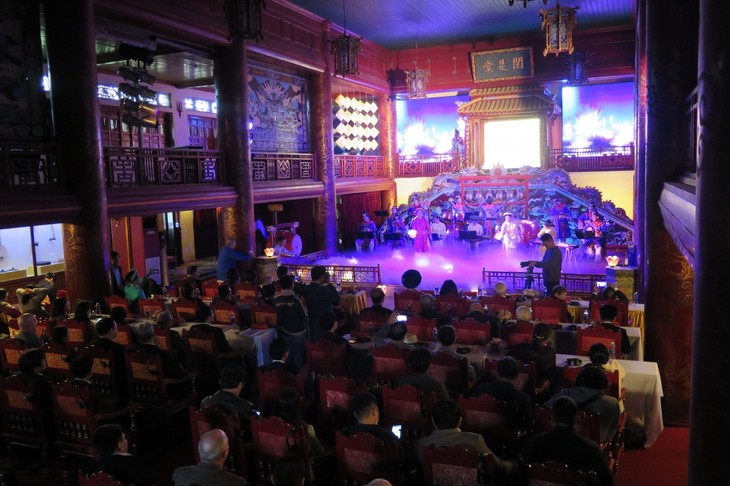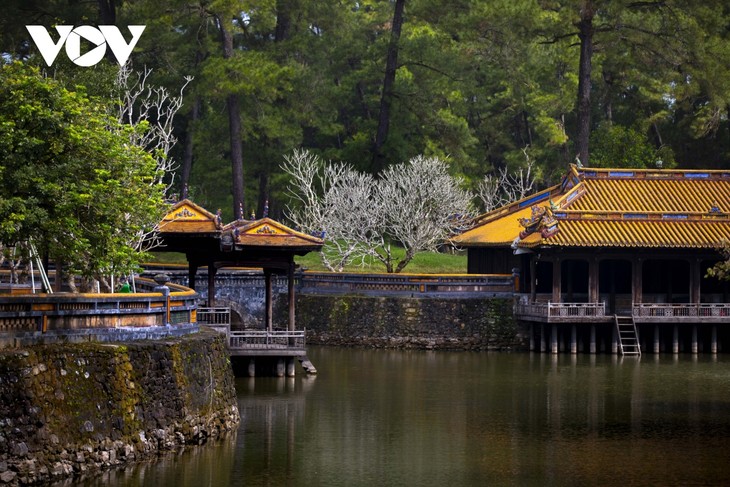(VOVWORLD) - Three decades ago, the Complex of Hue Monuments was the first in Vietnam recognized by UNESCO as a World Cultural Heritage. The complex is now one of the heritages that have been best preserved.
 Duyet Thi Duong is the Hue royal theater (Photo: VOV) Duyet Thi Duong is the Hue royal theater (Photo: VOV) |
Before being recognized by UNESCO as a World Cultural Heritage, the Complex of Hue Monuments had about 850 architectural structures, but only 460 works were still intact. Some had become ruins and 80% of the structures were in urgent need of repair.
After receiving a nod from the Government, the Hue Monuments Conservation Centre implemented a master plan to conserve of the complex between 1996 and 2010 with an investment of 30 million USD.
Subsequently, the government approved 97 million USD to conserve, restore, and upgrade more than 170 structures and components in the 2010-2020 period.
Many relic sites, including the Ngo Mon Gate, the Hien Lam Pavilion, The Mieu Relic Complex, Dien Tho palace, the Duyet Thi Duong theater, many other palaces, tombs and monuments worshipping of the Nguyen Emperors were renovated and have become tourist attractions.
Ms. Ho Ngoc Anh Thu, a visitor from Ho Chi Minh city, said: “It is essential to renovate the relic sites so that today’s generation can understand more about Vietnam’s history.”
Other projects are underway to renovate other relic sites, including the Hue Museum of Royal Antiques, the Temple of Literature, Can Chanh temple, and Minh Mang tomb, Thieu Tri monument, and Tu Duc tomb.
Phan Van Tuan, Deputy Director of the Hue Monuments Conservation Centre, said the center has worked out plans to preserve and renovate the Complex of Hue Monuments until 2030 with a vision to 2050 and submitted it to the Ministry of Culture, Sports, and Tourism and the Prime Minister for approval. Tuan said: “This plan will serve as a foundation for preserving the relics. We have specified the areas which need to be preserved so that the preservation won’t adversely affect local people and will boost the economy.”
 Tu Duc Tomb (Photo: VOV) Tu Duc Tomb (Photo: VOV) |
According to UNESCO, conservation of the Hue Monuments has become more stable. Christian Manhart, UNESCO Chief Representative in Vietnam, said many heritage sites have been restored and the conservation work is continuing.
Associate Professor Dr. Dang Van Bai, Vice Chairman of the National Cultural Heritage Council, said the Hue Monuments Complex is reviving day by day: “The Hue Monuments Conservation Center has become a model for Southeast Asia in preserving wooden architectural heritages. The Hue Royal Palace is a good example. Beginning with giving the relic international emergency status requiring special support, conserving the relic has now moved to a period of stable progress,” said Bai.
Thua Thien-Hue province is the only locality in Southeast Asia that has 7 UNESCO-recognized heritage sites. 5 of them are in Hue city, including the Hue Monuments Complex, Vietnamese Court Music, which was recognized by UNESCO as an intangible heritage in 2003, and 3 documentary heritages (woodblocks of the Nguyen Dynasty, recognized in 2009, imperial records of the Nguyen Dynasty, recognized in 2014, and poetry about Hue royal architecture, recognized in 2016).
Thua Thien-Hue shares with other localities two other UNESCO heritages – Bai Choi folk singing of central Vietnam and the Mother Goddess Worship Ritual.
To preserve Hue's cultural heritages is to preserve the nation's cultural assets and contribute to preserving humanity's cultural treasures. It is part of Vietnam’s commitment to UNESCO to manage, protect, and promote cultural heritages and its effort to strengthen Vietnam-UNESCO cooperation in conserving this legacy for future generations.